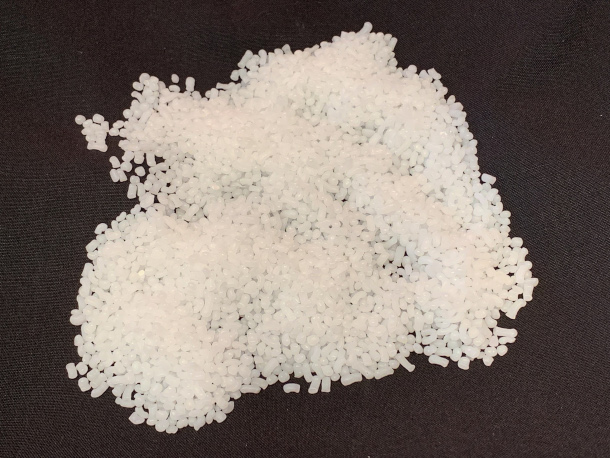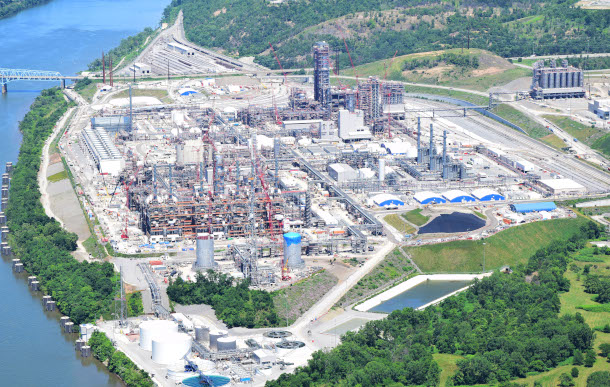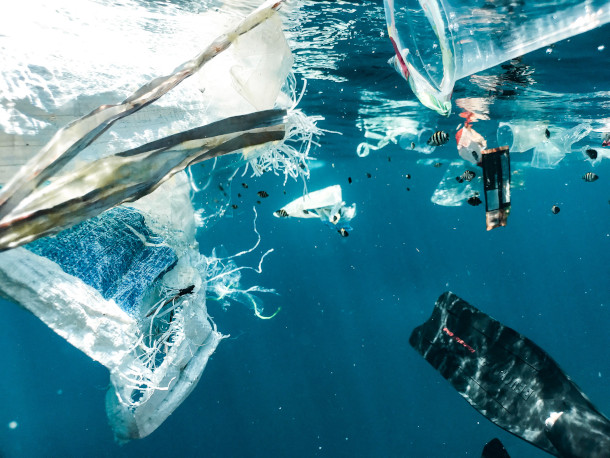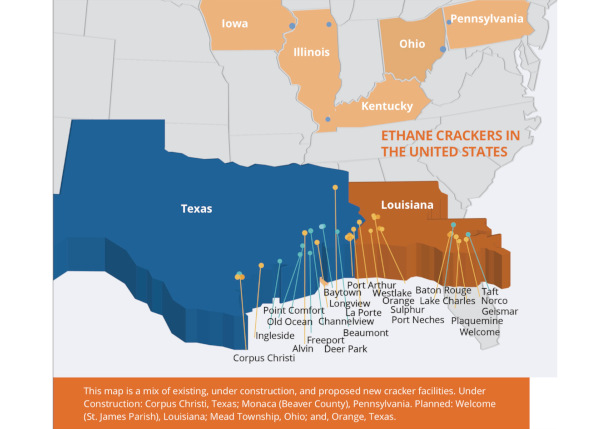The Climate and Plastic
Air Date: Week of October 29, 2021

Plastic nurdles are tiny pieces of plastic created by ethane cracker plants and constitute the primary feedstock of plastic manufacturing. (Photo: Mark Dixon, Flickr, Public Domain)
Plastic pollution is one of the biggest environmental threats to this planet, and according to a report by the advocacy group Beyond Plastics, greenhouse gas emissions from plastic production in the United States are on track to outpace domestic coal emissions. Judith Enck, a former regional administrator of the EPA and founder of Beyond Plastics, co-authored the report and joins Living on Earth’s Bobby Bascomb to discuss.
Transcript
CURWOOD: From PRX and the Jennifer and Ted Stanley Studios at the University of Massachusetts Boston, this is Living on Earth. I’m Steve Curwood.
As many world leaders gather in Glasgow Scotland for a UN Climate Summit, there is yet another factor to consider in facing the climate emergency, and it’s called plastic. According to a report from the advocacy group Beyond Plastics based at Bennington College, plastic production in the US is on track to outpace domestic coal in terms of greenhouse gas emissions. Analyzing data provided by plastic manufacturers to the federal government, the firm Material Research looked at every aspect of plastic manufacturing, cradle to grave, to determine how much plastic is contributing to climate change. They found that in 2020 the plastics industry was responsible for roughly 232 million tons of greenhouse gas emissions, roughly equivalent to those of 116 typical coal fired power plants. And that number is set to increase dramatically as fossil fuel companies continue to invest in more plastic production. Judith Enck is a former regional administrator of the EPA and founder of Beyond Plastics, and co-author of their report titled, The New Coal: Plastics and Climate Change. She spoke with Living on Earth’s Bobby Bascomb.
BASCOMB: So this report really marches through the 10 stages that you outline of plastic production, cradle to grave, starting with hydro fracking. Now, I think a lot of our listeners might be familiar with hydro fracking for natural gas energy but how does that feed into plastic production?
ENCK: Well, they are attached at the hip. It's because of the massive increase in hydro fracking in the United States we're seeing this big expansion of plastic production. What's happening is we have about 1 million hydro fracking sites throughout the country. And at the actual sites, you have methane gas that is vented into the atmosphere is a waste gas, it's never really captured. And what we're seeing at a small number of these sites, but it's still significant, is pipelines are being constructed to capture some of that gas and bring it to new multibillion dollar ethane cracker facilities. These are enormous manufacturing plants, where the gas is heated at very high temperature and then cracked. That's why it's got the funny name of cracker. There's nothing delicious about it and that then becomes the building block of single use plastic packaging. So at these ethane cracker facilities, at the end, you get billions of little pieces of plastic that are used. They're then shipped off to facilities where they make plastic packaging. One of the big problems is the ethane cracker facilities are super emitters of carbon.
BASCOMB: Now you say in your report that expanding ethane gas cracking facilities would add up to another 110 million tons of greenhouse gas in the next few years. Can you tell us about that please?

An ethane cracker facility owned by Shell in Beaver County Pennsylvania. (Photo: Ted Auch, FracTracker Alliance, Flickr)
ENCK: Sure. So, ethane crackers are probably what I'm worried about the most on this issue, because they are just so large, and are emitting such huge amounts of not just greenhouse gases but also air toxins and particulate matters for people who live near these facilities. There are currently 35 operating ethane cracker plants in the United States that are emitting 70 tons of greenhouse gases each year. That's the equivalent of 35 coal fired power plants. There are 12 Major cracker expansions proposed at existing locations and there are two really big ones that are poised to start operating very soon. One is owned by Shell in Bucks County, Pennsylvania and then there's a joint venture between Exxon Mobil and SABIC in Corpus Christi, Texas. And then there are another three new cracker facilities proposed. And what people need to realize that when they're these expansions are happening at existing locations, that is adding to the pollution burden of low income communities, communities of color, that already are being disproportionately impacted by this pollution.
BASCOMB: And a lot of these new ethane cracker facilities that are in the works are in an area, you know, colloquially called cancer alley. I mean, this is an area where people are already exposed to a lot of petrochemicals and industry and things like that. So to what degree do you see this as an environmental justice issue?
ENCK: This is probably one of the most serious environmental justice issues facing our nation. As you mentioned, these facilities are proposed in an area of Louisiana called cancer alley. It has that terrible name because of mostly air toxics and water pollution coming from the facility. And I think now we can call it climate change alley, because more than 90% of the climate pollution that the plastics industry has reported to the EPA occurs in only 18 communities. And this is mostly along the coastline in Louisiana, and Texas, and these are almost all low income communities and communities of color. And so we see the clustering of facilities. It's almost like the federal and state regulatory agencies have decided that there are sacrifice zones in our country. You already have a lot of petrochemical facilities so more are being added.

Plastic kills and endangers wildlife from birds to fish and there are estimated to be about 269,000 tons of plastic in the ocean. Invertebrates are especially susceptible; for example, when oysters eat plastic their immune system is weakened, thinning out their external shell and making them an easier catch for predators. (Photo: Naja Bertolt Jensen on Unsplash, Creative Commons)
BASCOMB: Well, why is plastic production increasing so dramatically? I mean is there really an increasing demand from consumers for more plastic? Or is this possibly more driven from the fossil fuel companies that make the raw material for it?
ENCK: It's absolutely not being driven by consumers. In fact, data is showing that consumers are looking for alternatives to plastic and it's hard when you're in an American supermarket, no matter how careful you are. This is happening because plastics is the plan B for the fossil fuel industry. Most of the fossil fuel profits come from two big businesses. One is electricity generation. And what's happening there? We're finally seeing a significant shift toward energy efficiency and renewable energy projects like wind, solar, small scale, hydro, geothermal. So the fossil fuel folks knew a long time ago that that shift away from relying on fossil fuels for power was reducing. At the same time, their second big profit center is transportation fuels. Well, what's going on there, we're electrifying more and more people are buying electric cars. big truck fleets are eventually switching over to electric vehicles. So the fossil fuel industry knows that their market for electricity generation and transportation is reducing. So that's why I say they are counting on plastics as being their plan B as their big market share. And there's already a lot of integration between chemical companies and fossil fuel companies. A lot of the names we recognize not only make fossil fuels, they also make chemicals. So unless you live in a community where one of these ethane cracker facilities are proposed, or a new pipeline is proposed, there's really not much general awareness that this is happening.
BASCOMB: Well the other end of the lifecycle of plastic is either recycling incineration or landfill generally, can you tell us about the greenhouse gas emissions associated with with each of those outcomes?
ENCK: Well, very little from recycling, thank goodness. But as I've said on your show, before, people should really only be recycling number one, and number two plastics and in a few communities, number five, because most plastics are not recyclable. Over 90% of plastics are not recycled. If plastics go to a landfill, they typically are not releasing greenhouse gases but they sure are if they are going to garbage incinerators of which there are about 75 In our country. So if plastic is burned at municipal waste incinerators it's releasing about 15 million tons of greenhouse gases a year which is about seven average sized coal fired power plants. And then I would add, when you burn plastic you also get dioxin emissions and other, other contaminants.

According to the report by Beyond Plastics, more than 90% of the climate pollution that the plastics industry reports to the EPA occurs in 18 communities, mostly along the coastline of Texas and Louisiana. The image above points to the area of ethane cracker facility concentrations, with blue dots showing existing facilities and red and orange showing proposed. (Photo: Screenshot of The New Coal: Plastics and Climate Change by Beyond Plastics report)
BASCOMB: Now, President Biden has set a goal of slashing greenhouse gas emissions by 50% in the next nine years by 2030. How do you think plastic production should fit into that agenda? And for that matter, what is the Biden administration doing in terms of addressing plastic pollution and greenhouse gas emissions from plastic?
ENCK: They're doing virtually nothing. So right now, I would say the issue is missing in action. And we're going to be working very hard in the months ahead, to get plastics on the climate change agenda, both at the state and federal level. And I might add, we're going into the COP26, United Nations convening for a couple weeks in Glasgow, Scotland and I've scoured the agenda for Glasgow and I do not see plastics on that agenda at all. And the United Nations has been really putting a spotlight on the problem of plastics in the ocean. They've released some very important data on this, but even the UN is missing the whole lifecycle. Such a sophisticated, important body, but they're really just focused on the end, the massive amount of plastics that get into rivers and oceans. And our life work now is to get these bodies to focus on production, use and disposal. So we view this report was a clarion call to policymakers and businesses. Yes, let's keep working, driving down greenhouse gas emissions wherever we can but don't leave plastics out of the equation, because then we're going to be regretting that all of our good hard work to phase out fossil fuels for energy and transportation may get canceled out with this uptick in plastic production.
CURWOOD: Judith Enck the founder of Beyond Plastics, speaking with Living on
Earth’s Bobby Bascomb. And Bobby joins me now for more. Hey there Bobby.
BASCOMB: Hey Steve! So we reached out to the fossil fuel companies Judith mentioned here: Shell, Exxon, and SABIC but we didn’t get any responses about this report. The Plastics Industry Association though told Waste 360 that “it’s no surprise that an organization named Beyond Plastics would cherry pick data to fit their narrative.” And they go on to defend plastic saying it’s more light weight than alternatives including glass and metal. So, they claim plastic uses less energy and has lower carbon emissions.
CURWOOD: Ok, well thanks Bobby.
BASCOMB: Sure thing, Steve.
CURWOOD: That’s Living on Earth’s Bobby Bascomb.
Links
Reach the report by Beyond Plastics The New Coal: Plastics and Climate Change
Read a report by The Plastics Industry Association
Rolling Stone | “Report: Plastic May Soon Overtake Coal as a Climate Killer”
Living on Earth wants to hear from you!
Living on Earth
62 Calef Highway, Suite 212
Lee, NH 03861
Telephone: 617-287-4121
E-mail: comments@loe.org
Newsletter [Click here]
Donate to Living on Earth!
Living on Earth is an independent media program and relies entirely on contributions from listeners and institutions supporting public service. Please donate now to preserve an independent environmental voice.
NewsletterLiving on Earth offers a weekly delivery of the show's rundown to your mailbox. Sign up for our newsletter today!
 Sailors For The Sea: Be the change you want to sea.
Sailors For The Sea: Be the change you want to sea.
 The Grantham Foundation for the Protection of the Environment: Committed to protecting and improving the health of the global environment.
The Grantham Foundation for the Protection of the Environment: Committed to protecting and improving the health of the global environment.
 Contribute to Living on Earth and receive, as our gift to you, an archival print of one of Mark Seth Lender's extraordinary wildlife photographs. Follow the link to see Mark's current collection of photographs.
Contribute to Living on Earth and receive, as our gift to you, an archival print of one of Mark Seth Lender's extraordinary wildlife photographs. Follow the link to see Mark's current collection of photographs.
 Buy a signed copy of Mark Seth Lender's book Smeagull the Seagull & support Living on Earth
Buy a signed copy of Mark Seth Lender's book Smeagull the Seagull & support Living on Earth

